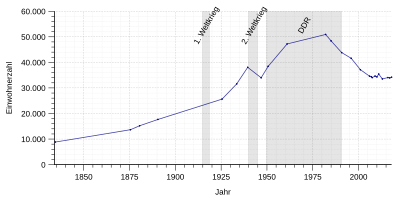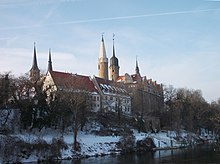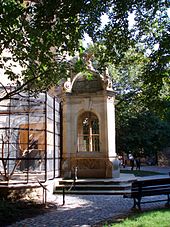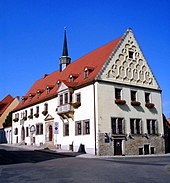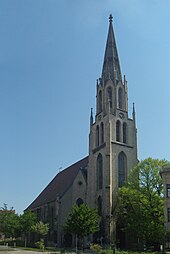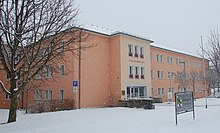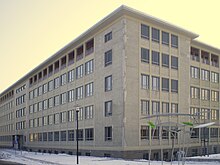Merseburg
| coat of arms | Germany map | |
|---|---|---|

|
Coordinates: 51 ° 21 ' N , 12 ° 0' E |
|
| Basic data | ||
| State : | Saxony-Anhalt | |
| County : | Saalekreis | |
| Height : | 88 m above sea level NHN | |
| Area : | 53.76 km 2 | |
| Residents: | 33,873 (Dec. 31, 2019) | |
| Population density : | 630 inhabitants per km 2 | |
| Postal code : | 06217 | |
| Area code : | 03461 | |
| License plate : | SK, MER, MQ, QFT | |
| Community key : | 15 0 88 220 | |
| LOCODE : | DE MEG | |
City administration address : |
Lauchstädter Str. 1-3 06217 Merseburg |
|
| Website : | ||
| Lord Mayor : | Jens Bühligen ( CDU ) | |
| Location of the district town of Merseburg in the Saale district |
||
Merseburg is a cathedral and university town on the Saale in southern Saxony-Anhalt . It is the administrative seat of the Saalekreis and part of the transnational conurbation of the cities of Leipzig and Halle . In the metropolitan region of Central Germany , which is largely shaped by these two regional centers , Merseburg functions as a medium- sized center . The chemical sites Schkopau (Buna) and Leuna border directly on Merseburg .
Merseburg, one of the oldest cities in Central Germany, was elevated to the status of a royal palace in the 10th century and is considered the hometown of the Merseburg magic spells from the 9th / 10th. Century. The first mention in the 9th century as "Mersiburc civitas" indicates an already existing fortified settlement. In fact, persistent settlements can be found since the Neolithic .
From the beginning with the establishment of the diocese of Merseburg in 968 by King Otto I until the time of the Reformation , Merseburg was an important religious center. From 1656 to 1738 Merseburg was the seat of the Dukes of Saxony-Merseburg and from 1815 to 1933 the capital of the administrative district of the same name in the Prussian province of Saxony .
geography
location
Merseburg is located on the eastern edge of the Querfurter Platte, mainly on the left bank of the Saale, into which the Geisel flows in the urban area . The city forms the gateway to the region of the Saale- Unstrut Valley, rich in palaces and castles .
To the northeast, Merseburg borders on the Saale-Elster-Aue , to the west on the Lower Geiseltal region .
City structure
The urban area includes the places Merseburg, Annemariental, Atzendorf , Beuna (Geiseltal) , Blösien , Elisabethhöhe, Freiimfelde, Geusa , Kötzschen , Meuschau , Neumarkt , Trebnitz , Venenien , Gut Werder and Zscherben .
Localities
The localities belong to Merseburg:
| Locality | Districts |
|---|---|
| Beuna (Geiseltal) | Niederbeuna, Oberbeuna |
| Geusa | Atzendorf, Blösien, Geusa, Zscherben |
| Merseburg | Altenburg (suburb), Annemariental, Elisabethhöhe, Freiimfelde, Kötzschen, Merseburg, Neumarkt (suburb), Gut Werder, Venenien |
| Meuschau | Meuschau |
| Trebnitz | Trebnitz |
Incorporations
| Former parish | date | annotation |
|---|---|---|
| Altenburg (suburb) | 1832 | Incorporation to Merseburg |
| Atzendorf | 07/01/1950 | Incorporation to Geusa |
| Beuna (Geiseltal) | 01/01/2009 | Incorporation to Merseburg |
| Foolishness | 07/01/1950 | Incorporation to Geusa |
| Geusa | 01/01/2010 | Incorporation to Merseburg |
| Kötzschen | 07/01/1950 | Incorporation to Merseburg |
| Meuschau | 05/30/1994 | Incorporation to Merseburg |
| Neumarkt (suburb) | 1832 | Incorporation to Merseburg |
| Niederbeuna | 04/01/1934 | Merger with Oberbeuna to form Beuna |
| Oberbeuna | 04/01/1934 | Merger with Niederbeuna to form Beuna |
| Trebnitz | 01/01/2003 | Recirculation from Kreypau to Merseburg |
| Veins | 01/01/1949 | Incorporation to Merseburg |
| Shatter | 07/01/1950 | Incorporation to Geusa |
Neighboring communities
Bordering communities of Merseburg are Schkopau in the north, Leuna in the south and Braunsbedra and Bad Lauchstädt in the west. The place Schkopau is 6 km north of Merseburg, the city of Leuna 5 km south. As a result of incorporations, the districts of Schkopau and Leuna border Merseburg in the east.
Name interpretation
From Thietmar von Merseburg until the Renaissance , the name of the city was derived from the Roman god of war Mars , according to which the place was supposedly founded by Roman soldiers.
The first term of the city name is ambiguous. For example: Old Saxon meri and Germanic mari for stagnant water, watery terrain or swamp. Furthermore, the reduction of a Germanic personal name with two terms such as Merifrid, Merowig, Meriswid or Meriswind or the short form Marso would be conceivable. Ultimately, the name of a tribal group such as Marsi, Marsaki or Marsingi cannot be ruled out, because Merseburg was in the Friesenfeld and the original settlement by splinter groups from the North Sea coast is quite possible.
The interpretation of the city name from Slavic linguistic means, such as Mezibor ('borderland'), has insufficient basis and is rejected by linguists.
history
Prehistory / antiquity
The first settlement in the area of today's Merseburg can be traced back to prehistoric times. In the Merseburg Museum you will find finds from the graves of the band and cord ceramics , the Bronze Age , the late Hallstatt Age , the Roman Empire , the Migration Period and settlements of the Elbe Slavs .
middle Ages
The first written mention of Merseburg was in the years 881/899 in the Hersfeld tithe list as " mersiburc civitas ". After 919 the place was expanded to a palatinate by King Heinrich I. Heinrich had married the daughter of the Merseburg Count Erwin, so that the place came under the rule of the Saxon manor house. He strengthened the fortifications on the castle hill and, after his victory against the Hungarians near Riade, had the dining room decorated with frescoes. At the same time he settled as reinforcement in the outer bailey a troop made up of spared thieves and robbers, the so-called “Merseburg crowd” ( legio Mesaburiorum ).
In 955 King Otto I vowed to found a diocese after he had finally defeated the Hungarians in the battle of the Lechfeld . Thereupon the diocese of Merseburg was founded by him and at the instigation of the Synod of Ravenna in 968 . Merseburg was previously on the border of the Hassegau .
The diocese was dissolved again in 981 and only re-established in 1004 by King Heinrich II . Until the Reformation, Merseburg was to remain a bishopric and an important religious center on the eastern border of Germany, after the area had previously belonged to the Halberstadt diocese . The diocese was one of the smallest German dioceses in terms of area, but included important centers such as the city of Leipzig , the south of what is now Saxony-Anhalt and parts of what is now the Free State of Saxony . At the end of the Middle Ages it comprised around 310 parish and subsidiary churches as the center of the Merseburg Monastery and was the residence of 43 bishops over the years.

A Benedictine monastery in Merseburg was first mentioned in 1012 . In the years 1015 to 1021 Heinrich II., Who clearly preferred Merseburg among his palatinate places, had the cathedral of St. John the Baptist and Laurentius built here. The crypt , begun in 1036, is still preserved from this building . Around 1280 the cathedral was decorated with highly regarded glass paintings, which were later lost and were replaced by Charles Crodel from 1947 to 1960 in a modern continuation of the medieval design language.
In 1188, Emperor Friedrich I Barbarossa founded a new market in what is now the suburb of Neumarkt. The Neumarktkirche was also attested for the first time. At that time, the first Saale bridge already existed here. In the meantime, Merseburg already had a far-reaching influence as a trading center, as evidenced by the name of the Brama Merseburska (Merseburger Tor) in Kulm, 490 kilometers away, in West Prussia . In the years 1218/19 the market on the left bank of the Saale was protected by a city wall, which was attached to the already fortified cathedral freedom . A civil self-government of the city was mentioned for the first time in 1289, the coat of arms of the city appears on the seal of a document. In 1323, the first of six serious city fires destroyed large parts of the city.
In 1428 Merseburg joined together with other cities and against the resistance of the bishops of the Hanseatic League , to which it should belong until at least 1604. Around 1470 the three-wing castle (the fourth wing is the cathedral) was rebuilt in the late Gothic style. The first print shop was located in Merseburg as early as 1473 .
In the 15th century, Bishop Thilo von Trotha (1466–1514) had the three-winged palace complex redesigned. When Leipzig was divided in 1485, Merseburg was added to the Albertine Duchy of Saxony .
Modern times
In the course of the Reformation and the beginning of the peasant wars , the Merseburg citizens and farmers wrote the 16 Merseburg articles in which they objected to the constantly new services and taxes (taxes on water, wood, pasture land, fields, the delivery of small cattle, numerous fines, etc.) . On May 3, 1525, Bishop Adolf had to flee to Leipzig due to unrest. On May 8th, the rebels tried to storm the cathedral freedom. After conviction in court hearings in June, four citizens and four peasants were beheaded on June 10, 1525 on the Merseburg market.
In the years 1510 and 1537, major renovations took place at the cathedral.
Around 1543 the Reformation began to leave its mark in Merseburg . In 1545 Martin Luther preached in Merseburg Cathedral. After the death of the last Catholic bishop in 1561, the Reformation finally took hold in Merseburg. The Benedictine monastery was dissolved and partially demolished. In 1575, the Merseburg High School was founded on the basis of the old cathedral school . The monastery territory was secularized and came into the possession of the Electors of Saxony . Until the beginning of the 18th century, however, it was to retain its own monastery government on behalf of the prince to administer the country. Furthermore, Merseburg was the main town of the Merseburg high school Merseburg . In the years 1605 to 1608, extensive renovations and extensions were made to the castle.
From 1621 to 1622 Merseburg had a tipper mint, where interim coins were struck under mint master Georg Sömmerling. These were kipper coins from the Kipper three-pfennig piece to the so-called Kippertaler for 60 groschen.
From 1656 to 1738 Merseburg was the royal seat of the Dukes of Saxe-Merseburg . This time was associated with brisk construction activity and a cultural boom for the city. As a result, Merseburg fell back to the Electorate of Saxony, to which it belonged until 1815.
19th century

After the Congress of Vienna in 1815, Merseburg became the capital of the Prussian administrative district of Merseburg and the district of Merseburg in the province of Saxony until 1945 . The Provincial Council, the parliament of the Province of Saxony, met for the first time in 1825 in the Merseburg Palace Garden Salon. In 1895 the provincial committee met for the first time in the plenary hall of the newly built Merseburg Estates building .
In 1832 the suburbs of Altenburg and Neumarkt were merged with the cathedral district and the inner city.
In 1841 the Merseburg magic spells were discovered in the Merseburg Cathedral Abbey Library .
In 1846 the city was connected to the Halle – Naumburg railway line .
1900-1945
In 1909 a new city hospital opened its doors, in its place today part of the Carl-von-Basedow Clinic stands.
In 1916/17 an ammonia plant was built on August-Bebel Straße in Merseburg , which formed the basis of the later Leuna works . In 1936/37 the Buna works in the neighboring town of Schkopau followed. In 1921 Merseburg left the Merseburg district and formed its own urban district.
In 1935 a military airfield was opened west of the city and an air garrison was stationed there.
The construction of the central canal as a bypass canal with a tow lock was started. This was supposed to replace the Meuschau and Rischmühle locks , but was not completed due to the war.
During the Second World War , Merseburg was bombed several times. The east wing of the castle and large parts of the city center were almost completely destroyed and the tow lock was damaged.
1945-1989
After the Second World War, Merseburg became the district town of the Merseburg district . The Technical University of Leuna-Merseburg was founded in 1954 . From 1955 on, residential construction concentrated primarily on the outskirts of Merseburg-Süd and Merseburg-West. From 1968 the so-called " socialist reconstruction " began in Merseburg , to which large parts of the old town fell victim. It wasn't until the political change in 1989 that entire streets began to decline and demolished.
Since 1990
In 1990 the first free elections since 1945 took place and a comprehensive redevelopment concept for the old town was initiated.
The turning point also meant the end of the NVA barracks on the western outskirts of the city. Since the mid-1980s, it housed a few hundred construction soldiers who had to work in the Buna and Leuna works.
Until 1991 Merseburg was still the location for the 6th Jagd-Bombflieger-Division and the 85th Guard-Jagdflieger-Regiment (16th Air Army) of the GSSD .
1992 Merseburg first took to the Hanseatic Days of Modern Times in part, the same year that was Fachhochschule Merseburg founded and from the city of Merseburg and communities Beuna (Geisel) and Geusa the administrative community Merseburg formed. At the end of March 1993, the Carl Schorlemmer Technical University was dissolved and divided equally between the Merseburg University of Applied Sciences and the Martin Luther University Halle-Wittenberg , Merseburg branch.
In 1994 Merseburg became the district town of the Merseburg-Querfurt district . The name was changed on December 23, 1997, when the city of Merseburg (Saale) was renamed Merseburg . In 2004 the city of Merseburg was included in the IBA ( International Building Exhibition Urban Redevelopment 2010). With its “New Milieus - New Opportunities” concept, the city of Merseburg tackled the problem of population decline and developed new strategies to reduce population losses.
In 2007, Merseburg became the administrative seat of the newly created Saalekreis district due to the regional reform in Saxony-Anhalt .
In September 2007, the then Lord Mayor Reinhard Rumprecht (independent) was charged with illegal possession of child pornographic material, which is why he resigned from his office.
From June 13th to 15th, 2008, together with the 40th Castle Festival, the Saxony-Anhalt Day took place in Merseburg under the motto “Merseburg enchants”. More than 200,000 people visited the city during this three-day national festival.
In 2009 the municipality of Beuna was incorporated into Merseburg, and in 2010 the municipalities of Geusa, Blösien and Zscherben.
Incorporations
Venenien was incorporated on January 1, 1949. The community of Kötzschen followed on July 1, 1950. Meuschau has belonged to Merseburg since May 30, 1994. Trebnitz was added in 2003. Beuna was incorporated on January 1, 2009. Geusa has been a district of Merseburg since January 1st, 2010.
Population development
Development of the population:
|
|
Data source from 1990: State Statistical Office Saxony-Anhalt
politics
Jens Bühligen (CDU) has been Lord Mayor since July 4, 2008 . He was re-elected in March 2015.
City council
With 14 seats, the CDU forms the strongest parliamentary group in the Merseburg City Council, followed by the “SPD / Bündnis90 / Greens” parliamentary group with 11 seats. The Left Party has 8 seats. The smallest parliamentary groups are the Statt party with 4 seats, the FDP with 2 seats and the NPD with one seat. The last election of the Merseburg city council took place in the course of the local elections in Saxony-Anhalt on May 25, 2014. Overall, the Merseburg city council has over 40 seats.
coat of arms
The coat of arms of the city of Merseburg shows in red over a continuous, tinned, black jointed silver round wall a stylized silver cathedral with four pointed, golden pommeled towers. The central towers are slightly raised and covered with an open Gothic church portal crowned by a gold cross with a linear black rosette. The outer towers each have three, the middle towers two black arched window openings next to each other. In the open portal, on an altar with a damascus golden cover, the golden nimbled black-haired head of John the Baptist is depicted on a golden bowl.
The colors of the city are red and silver (white).
Town twinning
Merseburg maintains city partnerships with
- Châtillon (Hauts-de-Seine) near Paris in France (since August 1, 1963)
- Genzano di Roma in Italy (since January 16, 1971)
- Bottrop in North Rhine-Westphalia (since March 10, 1989)
Culture and sights
Merseburg Cathedral Treasure
In 2008, the southern enclosure of the Merseburg Cathedral was rebuilt for the purpose of presenting the unique pieces of the Merseburg Cathedral treasure, which are known nationwide due to their special cultural and historical significance.
In the treasure chamber at the cloister of the Merseburg Cathedral you can see precious manuscripts such as the magnificently painted Merseburg Bible from the 13th century, a Romanesque portable altar, an ivory box from the middle of the 13th century and an altarpiece . The mummified hand of the opposing king Rudolf of Swabia , who fell in 1080, is also on display. Below the treasure chamber, in the “magic vault”, you can admire a facsimile of the famous Merseburg magic spells .
The Merseburg raven legend
The Bishop Thilo von Trotha owned a gold signet ring, a gift from his friend, the Bishop of Naumburg. One morning he left it by the open window and, after a short absence, noticed the loss of the ring. In his anger he accused his long-time servant of theft. Although the servant protested his innocence, he had him executed. Even after his head was chopped off, his outstretched arms are said to have protested his innocence. When the ring was later found in a raven's nest, Thilo von Trotha had a bird-farmer built in the castle courtyard as a warning not to pass judgment in a rage , in which a common raven has been paying for the theft ever since . As a permanent memento, the bishop added a raven with a ring in its beak to his coat of arms. - However, his family probably had this raven with ring in their coat of arms before. (See coat of arms of Krosigk , his possible place of birth)
Such a raven is still kept in a cage today, but the old custom is controversial among animal rights activists. In June 2006 the traditional cage in front of the castle was therefore significantly enlarged. The raven now lives with a partner in an aviary that is now almost nine meters long and four meters wide .
Museums, galleries and libraries
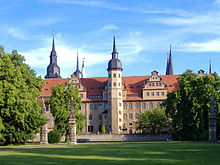
- Kulturhistorisches Museum Schloss Merseburg : In addition to exhibits from prehistory and early history, there are depictions of medieval Palatinate and diocese history, art and culture in the Duchy of Saxony-Merseburg and the modern history of the city. The palace and palace garden are part of the Garden Dreams Saxony-Anhalt project
- Deutsches Chemie-Museum Merseburg : Technical witnesses document the development of the chemical industry in the area around Merseburg and in the central German chemical region.
- Aviation and Technology Museum Merseburg : Exhibition about the technical development of the region and the GDR .
- Kunststiftung ben zi bena Merseburg eV : The art foundation offers alternating exhibitions of artistic perspectives from the former FRG and the former GDR alongside or against one another.
- Willi Sitte Gallery : The Willi Sitte Foundation for Realistic Art exhibits the artistic work and other works of art collected by the painter and graphic artist Willi Sitte . The gallery was opened in 2006 in the presence of former Federal Chancellor Gerhard Schröder (SPD).
- Galerie Tiefer Keller: Gallery that shows works by young artists in changing exhibitions.
- Art tank: Atelier, experimental stage and workshop in Domstrasse 5
- Peter Sodann Library: In 2006, under the chairmanship of actor Peter Sodann, the “Association for the Promotion, Preservation and Expansion of a Collection of Literature published in East Germany from 1945 to 1990” was founded. The aim of the association was to build up a library in Merseburg by 2009 with all the books published in the GDR and to make it accessible to everyone. However, the library was moved to Staucha .
Merseburg Organ Days
The internationally known Merseburg Organ Days have a permanent place in the musical life of Saxony-Anhalt and every year in September they attract numerous music lovers to the Merseburg Cathedral. Internationally renowned organists, famous orchestras and well-known soloists and choirs have made the organ festival known far beyond the borders of the region. Founded in the 1960s, it has been organized since 1994 by the Leipzig Gewandhaus and Merseburg Cathedral organist Michael Schönheit from the “Friends of Music and Monument Preservation in Churches of the Merseburg State eV” as part of the Saxony-Anhalt Music Festival .
The focus of the Merseburg Organ Days is the Merseburg Romantic Great Organ, created by Friedrich Ladegast from 1853 to 1855. Particularly associated with the name of Franz Liszt , the Ladegast organ is an instrument of outstanding musical history. Broadcasts on Mitteldeutscher Rundfunk and Deutschlandradio Kultur can also be heard regularly .
Buildings and parks
- Merseburg Castle with raven cage
- Chapter house Merseburg with cathedral monastery archive and library (exhibition of the Merseburg magic spells )
- Palace garden with palace garden salon and orangery , monuments, including the equestrian statue of King Friedrich Wilhelm III. , the iron cross and water feature
- Merseburg Ständehaus (culture and congress center) with monumental paintings by Hugo Vogel
- Market with old town hall and Staupenbrunnen (16th century) as well as the Saalealf-Brunnen (20th century)
- Zechsches Palais
- Cathedral pharmacy to the diamond wreath
- Gasthof zum Palmbaum
- Superintendent
- Crooked gate
- Black bastion
- French fountain
- Cathedral fountain
- Owl Tower with remains of the city wall
- Neumarktmühle (16th century)
- Neumarktbrücke (view of the Saale with Domburg)
- Neumarkt with St. Thomae Centuariensis church
- High Bridge (16th century)
- City cemetery St. Maximi with historical figures and chapel
- Recreation area Südpark and Rosengarten
- Gotthard pond with fountain, planetarium and the Klia drain towards the Saale
- City park and nature reserve "Saale-Aue" (Saale cycle path)
- Soviet cemetery of honor for 261 Red Army soldiers in Merseburg-Süd
- redesigned duck plan with fountain and the former Dobkowitz department store
- Monument to King Heinrich I by Paul Juckoff 1933
- Sculptures Sculpture symposium on the banks of the Saale
- numerous other fountains and sculptures spread over the city area, including the seasonal fountain
- Cathedral curia from the Renaissance and Baroque periods (Domstrasse), including In acie ambitus and Simonis et Judae
Churches
in italics the Latin patronage as links
- Merseburg Cathedral Sti. Laurentii et Johannis baptistae (with a Ladegast organ)
- City Church of St. Maximi
- Neumarktkirche St. Thomae Cantuariensis
- Altenburg Church of St. Viti
- Benedictine monastery St. Petri (founded in 1091; remains have been preserved)
- Church of St. Sixti (Romanesque church ruin with attached water tower from 1889)
- St. Norbert Church (Roman Catholic)
- St. Ullrich Church in Merseburg-Süd (Roman Catholic, consecrated in 1959 , profaned in 2016 )
- Church of the New Apostolic Congregation
in the districts:
- Church of St. Dionysius in Atzendorf
- Church in Niederbeuna
- Church in Oberbeuna (by Johann Michael Hoppenhaupt )
- Church of St. Thomas in Blösien with a Ladegast organ
- Kreuzkapelle in Freiimfelde
- Church of St. George in Geusa
- Church in Kötzschen (by Johann Michael Hoppenhaupt)
- Church of St. Georg in Meuschau
- Church of St. Cyriakus in Zscherben
such as:
- Parish hall of the Evangelical Free Church Congregation ( Brethren Congregation )
Regular events
- Merseburg New Year's Run (January 1st)
- Merseburg Festival of Puppet Theater (March)
- Merseburg DEFA Film Festival (March, since 2006)
- Merseburg Rabenmarkt , craft and pottery market at the cathedral (last weekend in March and October)
- Merseburg pub mile (always in May)
- Merseburg Castle Festival (June)
- International moat concerts (June-September)
- Barrel Organ and City Festival (August)
- Merseburg Organ Days (September)
- Central German Marathon (September)
- Merseburg Magic Festival (October)
- Merseburg Castle Christmas (December)
- Cabaret, lectures and concerts in the Ständehaus
- Merseburg Cathedral Music, organ sound 12 and motets in the cathedral
traffic
A connection to the rail network has existed since 1846 through the Halle – Bebra railway line . Until 2004, Merseburg station was a stop for interregional trains on the Frankfurt am Main – Berlin line. Until 1998 there was a direct train connection to Leipzig via Leuna and Günthersdorf, later the trains went to Leipzig-Leutzsch. In the 1960s, the Merseburg – Halle-Nietleben railway was built: a railway connection between Merseburg and Halle-Neustadt via the Buna works. The regional train line RB 81, which operates on this route, was discontinued in December 2007 due to a lack of passengers.
Merseburg can be reached every hour with the regional train line RB 25 (Halle – Saalfeld) and every two hours with the regional express lines RE 16 (Halle – Erfurt) and RE 18 (Halle – Jena). In addition, the regional train line RB 78 ( Merseburg – Querfurt ), which is operated by the Burgenlandbahn , begins in Merseburg . The RB 79 ( Merseburg – Schafstädt ), also starting in Merseburg, was discontinued on December 14, 2014.
From March 2011 the Merseburg railway junction was extensively modernized. Track and overhead line systems as well as an electronic signal box were newly built. At the station, the platforms and the pedestrian tunnel were completely renewed. The most extensive completion took place in 2013.
On April 11, 1913, the Merseburger Überlandstraßenbahn AG (MÜBAG) was founded to open up the brown coal area in the Geiseltal with an overland route to Müelte . Over the years, the line has been rebuilt and dismantled several times due to the expanding brown coal mine, which means that it is only used between Merseburg center and Merseburg south. In 1951 it became part of the Halle tram network . Merseburg also has a connection to the Halle tram network with the overland line 5 ( tram route Halle-Ammendorf-Bad Dürrenberg ), which is considered the longest continuous tram line in Europe. This is operated by Halleschen Verkehrs-AG (HAVAG). City bus and regional bus routes (including to Leipzig) are operated by the Merseburg-Querfurt local passenger transport company (PNVG).
Merseburg is connected to the federal motorway 9 ( Berlin - Munich ) via the Leipzig West / Merseburg junction . On the Südharzautobahn Bundesautobahn 38 ( Göttingen - Halle / Leipzig ), the Merseburg-Nord and Merseburg-Süd exits provide the connection to the city.
The federal road 91 Halle – Merseburg– Weißenfels - Zeitz runs through Merseburg , which has been developed as an expressway in the Halle – Merseburg area. Furthermore, the federal highway 181 to Leipzig begins here , which in Merseburg is partially expanded to four lanes. The Leipzig / Halle airport is located about 30 km north-east and is accessible via the B 181 and A ninth The lock Merseburg-Meuschau and the Rischmühlen lock make the Saale navigable .
Media and publishers
In Merseburg there is an office of the regional editorial office Halle / Saalekreis / Merseburg of the Mitteldeutsche Zeitung (Neuer Landbote). The city is also the seat of the weekly advertising papers Wochenspiegel and Supersonntag as well as numerous printing and advertising companies.
Since 1997, the Merseburg citizens 'television, the Open Channel Merseburg-Querfurt (OKMQ), has been one of the seven citizens' television stations in Saxony-Anhalt. The distribution area extends to the cable networks in Merseburg, Leuna, Bad Dürrenberg and Günthersdorf. The OKMQ program is also published as a live stream on the Internet.
Public facilities
In addition to the administrative headquarters of the Saalekreis district , Merseburg also has the Merseburg District Court and a police station.
The city of Merseburg maintains a city library, the cathedral city cinema, a swimming pool and, together with the district, the Rischmühlenhalle for club and mass sports.
The Carl von Basedow Clinic is the only hospital in the Saalekreis; it has about 650 beds. It is one of 9 hospitals specializing in care in Saxony-Anhalt . Ten clinics are located at the Merseburg site and three at the Querfurt site . The district is responsible for this. It serves as the academic teaching hospital of the Martin Luther University Halle-Wittenberg .
education
schools
Two grammar schools are located in Merseburg. The older of the two is the Domgymnasium, founded in 1575. The second grammar school is the Herder grammar school. There are also two secondary schools in the city. Five state and one privately owned primary schools (the Protestant Johannesschule) and two comprehensive schools are located in Merseburg. In addition, there are two special schools , one for the mentally handicapped and another for the learning handicapped, as well as a district adult education center and a district music school.
University of Merseburg
From the Technical University Leuna-Merseburg emerged Merseburg University was established on April 1, 1992nd It is divided into the fields of engineering and natural sciences , economics and information sciences , and social work.media.culture . There are currently eleven undergraduate bachelor's degree programs, nine postgraduate master’s degree programs and numerous advanced training programs. About 3000 students study at the university.
European Romanesque Center
On July 10, 2006, the European Romanesque Center was founded at the Martin Luther University Halle-Wittenberg as a non-profit association for the research and communication of European Romanesque. Since May 2008 it has been an affiliated institute of the Martin Luther University with its seat in the southern enclosure of the Merseburg Cathedral. The European Romanesque Center is a scientific research and public educational institution that bundles existing potentials and diverse activities on the subject of Romanesque in Saxony-Anhalt and networks them nationally and internationally. The intention is, on the one hand, to promote regional and supra-regional work on Romanesque and present it in specialist conferences, thereby giving younger scientists from all over Europe a platform for their research. On the other hand, the topic of Romanesque is to be communicated to a wider public.
Personalities
literature
- Friedrich Zollinger (arrangement): Merseburg. (= Germany's urban development ) Deutscher Architektur- und Industrie-Verlag (DARI), Berlin-Halensee 1922 (1st edition) / 1929 (2nd revised edition).
- Hans-Joachim Mrusek : Merseburg ( art history city books ). EA Seemann , Leipzig 1962, DNB 575564016 .
- City administration Merseburg (Ed.): Merseburg. Stadt-Bild-Verlag, Leipzig 2013, ISBN 978-3-942146-47-0 .
- Horst Wingrich: The historical water supply of Merseburg. Beucha, Markkleeberg 2012. ISBN 978-3-86729-108-8
Web links
- Official homepage of the city of Merseburg
- Pictures of Merseburg
- Database of monuments, culture and other sights of Merseburg
- Jürgen Jankofsky : Chronicle of the city of Merseburg
Individual evidence
- ↑ State Statistical Office Saxony-Anhalt, population of the municipalities - as of December 31, 2019 (PDF) (update) ( help ).
- ↑ Localities of Merseburg ( Memento of the original from September 27, 2015 in the Internet Archive ) Info: The archive link was inserted automatically and has not yet been checked. Please check the original and archive link according to the instructions and then remove this notice.
- ^ Ernst Eichler , Hans Walther : City name book of the GDR. 2nd Edition. Leipzig 1988, pp. 186-187.
- ↑ Paul Hirsch , Hans-Eberhard Lohmann (ed.): Widukindi monachi Corbeiensis rerum gestarum Saxonicarum libri tres. = The Saxon history of the Widukind von Korvei (= Monumenta Germaniae Historica . Scriptores. 7: Scriptores rerum Germanicarum in usum scholarum separatim editi. Vol. 60). 5th edition. Hahn, Hannover 1935, p. 68 ( digitized version ).
- ^ Karlheinz Blaschke , Uwe Ulrich Jäschke : Kursächsischer Ämteratlas , Leipzig 2009, ISBN 978-3-937386-14-0 , p. 84 f.
- ^ The district of Merseburg in the municipal directory 1900
- ^ J. Jankofsky, J. Sailer: Ständehaus Merseburg. Merseburg 1991.
- ↑ Stefan Wolter: "In the spirit of noble, helpful humanity." From the Merseburg Municipal Hospital to the Saale District Clinic - 100 years of history. Projekt-Verlag, 2009, ISBN 978-3-86634-847-9 .
- ↑ Photo book shows Merseburg through the ages Mitteldeutsche Zeitung from December 4, 2013
- ^ Soviet troops in Germany 1945 to 1994, memorial album, Moscow edition, «Junge Garde» publishing house, 1994; ISBN 5-235-02221-1 ; Page 21.
- ^ StBA: Changes in the municipalities, see 1997
- ↑ Municipalities 1994 and their changes since January 1, 1948 in the new federal states , Metzler-Poeschel publishing house, Stuttgart, 1995, ISBN 3-8246-0321-7 , publisher: Federal Statistical Office
- ^ StBA: Area changes on January 1, 2009
- ↑ StBA: Area changes from January 01 to December 31, 2010
- ↑ census database
- ↑ http://www.merseburg.de/de/ob-wahl-2015/dank-an-die-waehlerinnen-und-waehler-20009342.html
- ↑ Domgalerie Merseburg , accessed on October 2, 2013.
- ^ Library - Peter Sodann , accessed on October 2, 2013.
- ↑ Former churches of the parish of St. Norbert Merseburg , accessed on June 27, 2018
- ↑ Complete closure at Merseburg train station. supersonntag-web.de, June 6, 2013, accessed on November 26, 2015 .
- ^ Website of the Sachsen-Anhalt Media Authority , accessed on February 5, 2012.
- ↑ hs-merseburg.de








